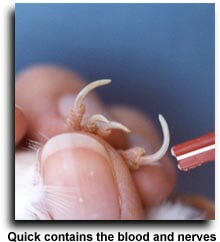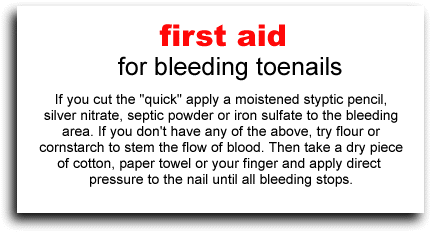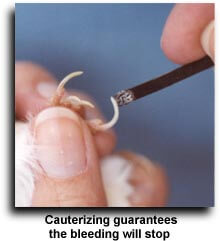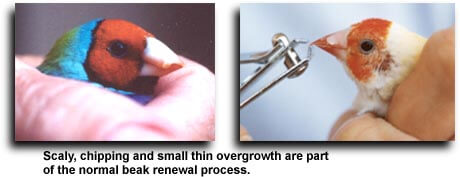 How to safely clip your bird's nails and beak - Title
How to safely clip your bird's nails and beak - Title
Nail and Beak Trimming
Articles and Information - Lady Gouldian Finch
Trimming your birds' nails and beak is a fairly simple procedure. However, I recommend that you do not trim your birds nails the first time until you have been trained by a competent pet store, professional groomer or avian vet. I will try to cover all the important information you should know before you begin
Abrasive wear in the wild
In the wild, a bird's normal activities keep the nail growth and nail wear balanced naturally. However, in captivity, a bird's nails seldom are exposed to the same abrasive wear as in the wild. Keeping our bird's nails and beak properly trimmed is less about good grooming and more about health, comfort and safety. Overgrown nails make perching and climbing difficult and uncomfortable. Nails that are too long can get caught in objects preventing the bird from flying freely and causing certain death.
Tools you will need
Human fingernail clippers will work on small to medium sized birds while dog nail clippers can be used on larger birds. Other essential tools are styptic powder, silver nitrate, iron sulfate or if you are going to release your birds into an outdoor flight, I would suggest you use a match or cigarette lighter to guarantee stopping any bleeding that may occur.
Beware of the quick!
 Quick contains the blood and Nerves
Quick contains the blood and Nerves
Cutting the nails is simple on birds with white-light nails like the Gouldian. Each bird nail has a "quick" - the living portion of the nail that contains blood and nerves. You can easily see the "quick" on the Gouldian because their nails are white. In white - light colored claws, the quick appears as a pinkish stripe that grows partway down the center of the nail. To find the quick in dark claws, turn the bird over to examine the underside of the claw.
Just a little at a time
It is best to pare off a little at a time, so that you do not cut into or expose the nail's quick. If the quick is cut, the nail will bleed profusely and cause the bird pain. The bleeding must be stopped immediately. If you can see the quick, snip off the nail just below it. If you can't see the quick, begin by cutting only a tiny amount from the nail, continue until you've trimmed the nails to their proper length.
 First aid for bleeding nails
First aid for bleeding nails
If you are going to release the bird back into a large flight or aviary, I suggest you use a match or cigarette lighter to guarantee the bird doesn't knock off the blood clot while flying from perch to perch. Sometimes heat is needed to stop really stubborn bleeding.
Cauterize for best results
 Cauterizing guarantees the bleeding will stop
Cauterizing guarantees the bleeding will stop
Cauterizing the nail will absolutely stop the bleeding. It will also not leave a clot that could be knocked off. Using a match stick, lite the match and allow it to burn for a couple of seconds, blow it out and immediately press it firmly to the tip of the nail. Hold it there until the match cools. The tip of the nail should be charred, if not repeat the process.
If the bird has lost an appreciable amount of blood, it should be kept at 80-85 degrees in a covered cage to keep the bird quiet for a few hours. It would help to give the bird Guardian Angel while in the cage and for several days after it is released back into the cage. Guardian Angel will help it get over the stress and shock of blood loss.
Beak trimming
Just like your bird's nails, his beak grows continually. Most birds will wear down their beaks naturally and will never need you to trim them. Periodically, thin splinters will chip off the tip of the beak. Sometimes you will see large and small thin, scaly pieces on the beak. This is a normal part of the renewal of the beak's tissue.
 Normal beak issues
Normal beak issues
 Overgrown Beak Photos
Overgrown Beak Photos
Consult your vet immediately
Some birds have abnormal or excessive beak growth or do not align correctly. In such cases the bird is hampered in its intake of food. If nothing were done to help, eating would eventually become impossible. Your avian veterinarian would be the best one to determine whether or not your bird's beak should ever be trimmed.
An easier and safer solution for you and your birds
You will find after you start using great supplements your bird's nails and beaks will grow even faster than normal. Nail growth is supported by exactly the same nutrients that promote feather production. The amino acids (and sulphur) are the main contributors to nail and beak growth. Often just using a calcium supplement will also increase nail growth which highlights how often calcium is deficient in traditional diets. Feathers, of course, will only grow when the bird decides to molt. Beaks and nails will grow continuously.
Easier and safer solution
It was very difficult for me to keep up with all the trimming required with the number of birds that I owned. I started to search for an easier solution. I found that the concrete and sand paper perch covers that other breeders recommended irritated my birds little feet. I contacted the Sandy Perch Company and started using their manzanita core perches. I found the perches provided the birds with a safe trimming source for both nails and beaks that regular dowel rods and tree branches don't provide. Plus they do not irritate the birds feet like the concrete and sand paper covered perches.
On size does not fit ALL
The one problem I found with many perches is they are manufactured too large for my finches. Be sure your perches are "finch" size perches.
© lady gouldian finch.com 2017